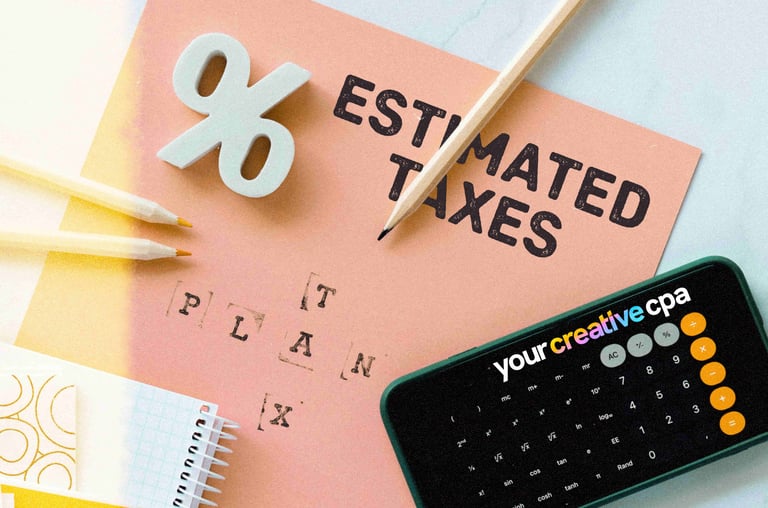
Easily Understand Your Finances With The Financial Health Check Template Today
Estimated Tax Guide for Creative Businesses
Learn what estimated taxes are, how and when to pay them, the best estimated tax calculators, and more for small business owners.
TAXHOMEPAGE - FEATURES - ROW 2
David Kindness, CPA
5/6/2025



Estimated Tax Guide for Creative Businesses
Published on May 5, 2025
Written by David Kindness, CPA
Why you can trust Your Creative CPA
Our content is written, edited, or both by industry experts who are creative entrepreneurs just like you. Learn more.
Whether you're a freelancer or a small business owner, running a creative business comes with many financial responsibilities, including paying taxes. Unlike traditional employees who have taxes automatically withheld from their paychecks, self-employed individuals generally must pay estimated taxes each quarter.
Failing to pay estimated taxes can lead to penalties and unexpected tax bills. This guide will walk you through everything you need to know about estimated taxes for freelancers and small business owners, including who needs to pay, how to calculate them, and the best tools to simplify the process.
Fast Facts About Estimated Taxes
Estimated taxes are due four times a year (AKA quarterly) in April, June, September, and January.
The IRS may charge penalties if you underpay, miss payments, or pay late.
Freelancers, independent contractors, gig workers, and small business owners typically need to pay estimated taxes.
In addition to regular income tax, they also owe 15.3% for Social Security and Medicare taxes.
Pay at least 90% of this year’s tax liability or 100% of last year’s (110% if high-income) to avoid penalties.
What are Estimated Taxes?
Estimated taxes are quarterly pre-payments on your income and self-employment taxes. Since freelancers and small business owners don’t have taxes withheld from their earnings, the IRS requires them to pay these estimated taxes throughout the year to avoid a large year-end bill. Estimated tax payments cover the following...
Federal Income Tax
These are the regular income taxes that all workers generally must pay to the federal government each year. This is a progressive tax levied by the U.S. government on your annual earnings, with rates ranging from 10% to 37% based on your income bracket. Freelancers and business owners must pay this tax quarterly if they expect to owe $1,000 or more for the tax year.
Self-Employment Tax
This tax is referred to as the FICA (Federal Insurance Contributions Act) tax, and it includes Social Security taxes of 12.4% and Medicare taxes of 2.9% for a total tax rate of 15.3%. for independent workers, applied to 92.35% of net earnings. Unlike W-2 employees, self-employed individuals pay both the employer and employee portions.
State Income Tax
These are just like federal income taxes, but they are paid to the state where you reside. If you live in AK, FL, NV, SD, TN, TX, WA, or WY, then you're in luck, because these states do not charge a state income tax. A tax imposed by most states on residents' income, with rates and rules varying widely—some states (like TX and FL) have no income tax. Freelancers may need to make quarterly payments if their state requires it.
Who Needs to Pay Estimated Taxes?
Almost all non-employees who earn income need to pay estimated taxes. Specifically, you'll likely need to pay estimated taxes if:
You expect to owe $1,000 or more in taxes this year.
You’re a freelancer, independent contractor, self-employed individual, or small business owner.
Your employer doesn’t withhold enough taxes from your paycheck (this is common for side hustlers).
You earn passive income (rental income, dividends, etc.) that are not subject to withholding.
There are a few exceptions, however. If you had no tax liability last year, no expected tax liability this year, or are a W-2 employee with sufficient withholdings, you may not need to pay estimated taxes.
When to Pay Estimated Taxes
Estimated tax payments are due four times each year, following the IRS's (Internal Revenue Service's) quarterly schedule. In general, estimated taxes are due by the 15th day of the month following the end of each quarter. These due dates may differ by a couple of days if they fall on a weekend or holiday. Missing deadlines can result in penalties, so it's important to mark these dates on your calendar and set up reminders:
Quarter 1 (Jan – Mar): Estimated payments are due by April 15
Quarter 2 (Apr – May): Estimated payments are due by June 15
Quarter 3 (Jun – Aug): Estimated payments are due by September 15
Quarter 4 (Sep – Dec): Estimated payments are due by January 15
It's important to note that state tax deadlines may be different than federal due dates. Check your state’s tax agency for payment options. You can find this information by typing "(state) estimated tax due dates (year)" into your favorite search engine.
How to Pay Estimated Taxes
Next, let's look at how to pay estimated taxes. Taxpayers can pay estimated taxes using a few different methods:
IRS Direct Pay: This option allows you to pay your estimated taxes electronically on the IRS website using your bank account information. It does not require you to enroll with the service, making it a great option for infrequent or casual payers. It's generally considered the most direct and secure option. This option is free.
Electronic Federal Tax Payment System (EFTPS): This is another online tax payment option offered by the federal government. It requires you to enroll in the service, but it allows payers to schedule payments in advance and track payment history, making it great for businesses with more frequent payment needs. This option is also free.
Pay by Mail: A more traditional option involves writing a check for the amount due and mailing it along with Form 1040-ES, "Estimated Tax Payment Voucher". This option is slower than paying electronically, and is generally considered less secure, but it is a great option for those who are not interested in paying with computers or the internet.
Credit or Debit Card: An uncommon option is to pay estimated taxes online using a credit or debit card. This option is quick and secure - just like the first two options - but is generally not advised because it involves paying credit card fees, which can be significant depending on the amount of your payment.

"Estimated taxes are quarterly pre-payments on your income and self-employment taxes."

How to Calculate Estimated Taxes
It's important to understand how your estimated taxes are calculated and why you must pay each tax. This allows you to optimize your taxes by tracking income and expenses and maximizing your deductions. Let's walk through the process of calculating your estimated federal taxes, step-by-step.
Step 1: Estimate Your Annual Income
The first step is to track your business income and deductible expenses so you can project your net profit. Your business income can include any goods or services you sell to clients, like photoshoots, paintings, music shows, jewelry, design services, etc. Your business expenses can include items that are ordinary and necessary for your business, such as internet, hard drives, art supplies, business travel, business meals, office supplies, business vehicle expenses, and more.
Pro Tip: Download Your Creative CPA's FREE business income cheat sheet and business expense cheat sheet to make recording income and expenses a breeze, no matter where you are.
Step 2: Calculate Self-Employment Tax
The self-employment tax is 15.3% (12.4% for Social Security + 2.9% for Medicare), and it is charged on 92.35% of your net income , which is your income after all expenses. For example, let's assume that you're a single filer and your net income is $50,000. The formula for calculating your self employment tax is: ($50,000 × 0.09235) × 0.153. As a result, your self-employment tax would be $7,064.78.
Step 3: Calculate Income Tax
In addition to estimating your self-employment taxes, you must also calculate your federal income taxes. Use the IRS's tax brackets to estimate your federal income tax. Let's continue the example we used above:
Single filer with a taxable income of $50,000
The 2024 tax brackets that apply to you are 10%, 12%, and 22%:
$11,600 × 10% = $1,160.00
($47,150 - $11,601) × 12% = $4,265.88
($50,000 - $47,151) × 22% = $626.78
As a result your estimated Income Tax is $1,160.00 + $4,265.88 + $626.78 = $6,052.66
Step 4: Add Taxes & Divide by 4
As we figured out in the last two steps, your estimated taxes for the year would be as follows:
Self-Employment Tax: $7,064.78
Federal Income Tax: $6,052.66
Total estimated income tax: $7,064.78 + $6,052.66 = $13,117.44
Quarterly Estimated Payments: $13,117.44 / 4 = $3,279.36 per quarter
Estimated Tax Calculators
While it's important to understand what you're paying in taxes and how your taxes are calculated, you do not always need to perform these calculations manually. There are several helpful estimated tax calculators on the market that automate this process for you. Let's explore a few such options:
Income Tax Calculators
IRS Tax Withholding Estimator: This free tool is offered directly from the IRS to help taxpayers estimate their quarterly taxes. It's is a valuable resource for calculating estimated payments.
TurboTax Estimated Tax Calculator: This free tool is provided by the highly-popular online tax filing software, TurboTax. It allows you to calculate your estimated taxes with just a few simple inputs.
H&R Block Tax Calculator: similarly to TurboTax, H&R Block is another popular tax filing solution. They also offer a free tool to easily calculate your estimated taxes.
Self-Employment Tax Calculators
QuickBooks Self-Employed Tax Calculator: QuickBooks is the most popular accounting and bookkeeping solution on the planet, and their free and simple tool for allows you to calculate your estimated self-employment taxes.
Forbes Self-Employment Tax Calculator: Forbes - the highly-acclaimed financial publisher - offers various free financial tools, including their self-employment tax calculator.
These tax calculators are incredibly helpful for saving time, maintaining accuracy, and you avoiding underpayment or late payment penalties by providing quarterly estimates in as little as a few clicks.
How to Pay Estimated Taxes While Staying Creative
Paying estimated taxes is an important task freelancers and creative business owners to get right. By calculating your taxes quarterly, tracking income, and using the right tools, you can avoid penalties, manage cash flow effectively, and stay compliant with the IRS.
If you’re unsure about your tax obligations, or if they seem a little too complicated for you to figure out on your own, consult a CPA or tax professional to ensure accurate and timely payments. Staying proactive and on top of your estimated taxes will help ensure a smooth and pain-free tax filing experience.
Frequently Asked Questions (FAQs)
What happens if I don’t pay estimated taxes?
The IRS may charge underpayment penalties and interest. To avoid this, follow the Safe Harbor Rule(paying 90% of this year’s tax or 100% of last year’s).
Can I pay estimated taxes all at once?
While you can make extra payments, the IRS still expects quarterly payments. Missing deadlines could result in penalties.
Do I need to pay state estimated taxes?
If your state has an income tax, you likely need to pay state estimated taxes as well. Check your state’s tax agency for requirements.
Disclaimer: the information provided in this article is for educational purposes only and does not constitute tax, accounting, investing, legal, or financial advice. The information in this article does not take into account your unique financial or business situation or goals, and YCCPA cannot be responsible for reader's financial decision-making. YCCPA's goal is to educate and support you on your creative business journey.
Written by David Kindness, CPA
David is a CPA (Certified Public Accountant) and professional photographer, videographer, and designer based in San Diego, California. Learn more.
Supported by Ads
Your Creative CPA is supported by the ads you may see in our articles and guides. These ads help us serve creatives like you.







financial wisdom for creatives, by creatives

Created by David Kindness
© 2025 Your Creative CPA | Terms
type1wild.com partner
Exclusive guides and tools for creatives, right to your inbox.









